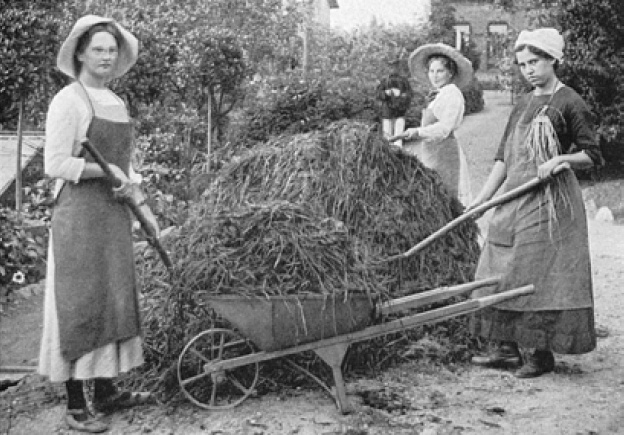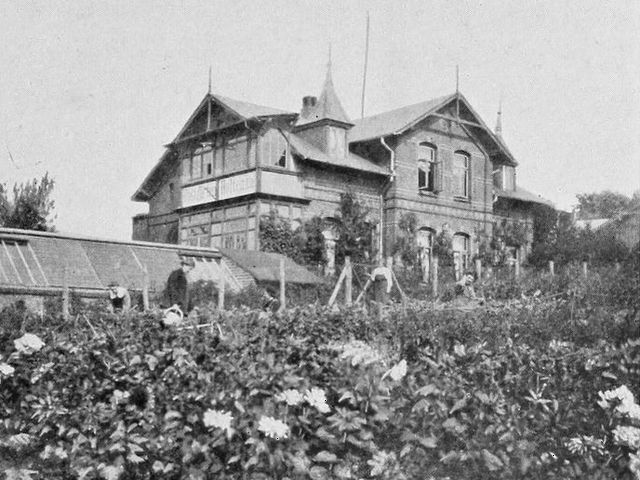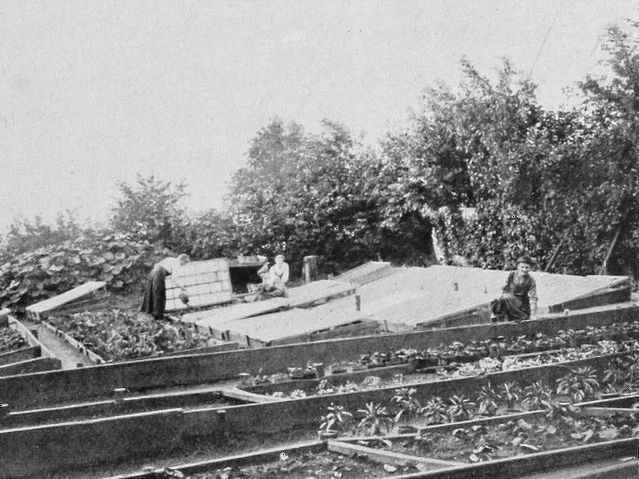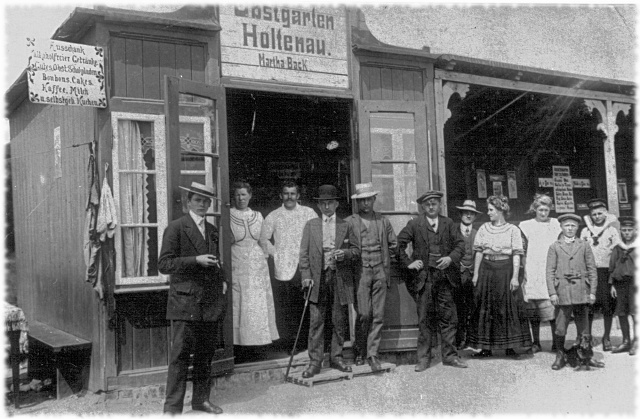 Abb.: In
der Gartenbauschule in Holtenau.
Abb.: In
der Gartenbauschule in Holtenau.Eine der ersten Obst- und Gartenbauschulen für Frauen im
Wilhelminischen Kaiserreich wurde von Martha Back1 in Holtenau gegründet. Frau Back führte zudem noch ein kleines
Ausflugslokal, den Obstgarten Holtenau
.
Die Geschichte der deutschen Gartenbauschulen für Frauen ging auf einen Artikel der damals
sehr beliebten Illustrierten Die Gartenlaube
aus dem Jahr 1880 zurück, in dem der
Vorschlag gemacht wurde, daß Privatleute und Frauenvereine mit Geld und Grundstücken zur
Errichtung einer praktischen Versuchsanstalt für die Berufsausbildung von Gärtnerinnen beitragen
sollten.
 Abb.: In
der Gartenbauschule in Holtenau.
Abb.: In
der Gartenbauschule in Holtenau.
10 Jahre später wurde in Charlottenburg bei Berlin schließlich eine erste Gartenbauschule
dieser Art durch Hedwig Heyl (1850 – 1934) eröffnet. Diese löste sie jedoch recht schnell wieder
auf, als bekannt wurde, daß Elvira Castner (1844 - 19232)3 seit Beginn des Jahres 1894 in
allen größeren deutschen Frauenzeitschriften die Gründung einer Obst- und Gartenbauschule
für gebildete Mädchen und Frauen
4 angekündigt hatte und schon im Herbst dieses Jahres den Schulbetrieb
aufnehmen wollte.
Eine der ersten Absolventinnen des zweijährigen Kurses war Martha Back aus Holtenau, die ihr Examen im Jahr 1896 machte.
 Abb.:
In der Gartenbauschule in Holtenau.
Abb.:
In der Gartenbauschule in Holtenau.
 Abb.:
In der Gartenbauschule in Holtenau.
Abb.:
In der Gartenbauschule in Holtenau.
Bedingung für die Aufnahme in diesen zweijährigen Kursus war das Abschlusszeugnis einer zehnklassigen höheren Mädchenschule. Der Kostenaufwand für die Ausbildung mit Schulgeld, Pension, Anschaffungen und Taschengeld betrug annähernd dreitausend Mark, eine beträchtliche Summe. Sie entsprach in etwa dem Jahresgehalt eines neu ernannten preußischen Amtsrichters. Durch diese Voraussetzungen war die Gärtnerinnenausbildung also tatsächlich exklusiv auf die gebildeten Töchter der wohlhabenden bürgerlichen Stände zugeschnitten.
Unter den ersten Absolventinnen, die 1896 nach zweijährigem Kursus mit dem Examen die Schule Dr. Castners verließen, war Marta Back. Sie eröffnete 1900 in Holtenau bei Kiel die zweite deutsche Obst- und Gartenbauschule für Frauen.
Dabei gehörte Marta Back zweifellos zu den führenden Vertreterinnen ihres Fachs. Für das 1913 erschienene umfassende Standardwerk „Frauenberufe und -ausbildungsstätten“ verfasste sie zwei Beiträge, über „Die Frau in der Gärtnerei“ und über „Die Gartenbaulehrerin“, und stellte eine Fotografie, die in ihrer Holtenauer Schule entstanden war, für diese Veröffentlichung zur Verfügung.5
Marta Back war eine sehr fähige Gärtnerin. Bereits 1903 wurde auf der schleswig-holsteinischen Gartenbauausstellung in Itzehoe das in ihrer Schule gezogene Obst und Gemüse mit Medaillen prämiert. Mehrere Auszeichnungen gingen auch 1906 für ihre Erzeugnisse an sie.
 Abb.: Das
Gartenlokal
Abb.: Das
Gartenlokal Obstgarten Holtenau
.
Als Lehrerin konnte sie den Erfolg verbuchen, daß auf dieser Obst- und Gartenbauausstellung fünf Schülerinnen für selbst entworfene Gartenpläne Preise erhielten. Im Jahr 1908 hatte die Schule 15 Schülerinnen. Im Jahr 1918 wurde die Obst- und Gartenbauschule an das Ostufer der Kieler Förde in das Villenviertel Kitzeberg bei Heikendorf verlegt, das auf Ländereien des Gutes Schrevenborn entstanden war.
 Abb.: Anzeige
der Holtenauer Gartenbauschule, dem "Institut für Frauen und Mädchen gebildeter Stände".
Abb.: Anzeige
der Holtenauer Gartenbauschule, dem "Institut für Frauen und Mädchen gebildeter Stände".
Die Gärtnerei Back befand sich in der Kastanienallee Nr. 18 am Ort des heutigen Gemeindezentrums.
In einem Bericht für ein Britisches Buch über Gartenbauschulen für Frauen schreibt Frau Back über die Schule in Holtenau:6
SCHOOL OF HORTICULTURE FOR LADIES, AT HOLTENAU, NEAR KIEL, SCHLESWIG-HOLSTEIN
I willingly comply with the request to contribute a short report of my work in connection
with the above institution, which I founded in 1901.
It is beautifully situated on an elevation gently sloping south towards Kiel Harbour, near the
Kaiser Wilhelm Canal. It contains two hot-houses, eighty forcing frames, about 500 fruit trees of
all sorts and kinds, a grand assortment of shrubs, ornamental trees and conifers. Two alleys of
high-grown pear trees (interlaced) in the shape of a large cross form the centre of the
garden.
I opened the school with five pupils; at present there are seventeen; The course of training is
two years for those who wish to take up gardening as a profession, and one year for amateurs.
The study is twofold: Practical and theoretical. Our practical course comprises : — ^Fruit
growing: How to grow best dessert fruit on large and small farm trees. Harvesting the fruit.
Storing and packing it. There are about forty different kinds of apples, thirty-five pear and
fifteen plum trees. Preserving various fruits in various ways. Then there is the annual grafting
of wild trees, the culture of farm trees, of high standard and half-high standards. We also grow
apples, pears, and peaches in pots and tubs. Vegetable growing includes forcing in the hothouse
and frames, as well as cultivation of all suitable kinds in the open field. I teach preserving
and wintering of vegetables. In flower growing we specially take those pot plants that sell well,
as : Chrysanthemum indicum, Primula obconica and chinensis, cyclamen, begonias, amaryllis,
hyacinths, tulips, cineraria, etc.- But of course we also cultivate exotics.
In the open we cultivate the favourite spring and summer flowers, annual and perennial roses,
etc. Thus we obtain abundant material for cut flowers, which serve for teaching the pupils to
make up bouquets, table decorations, etc. We use the garden stuff first of all for our own
household, but the remainder — by far the larger part — is sold in Kiel, thus teaching the pupils
the actual market value of their materials.
At the Schleswig-Holstein Horticultural Exhibition in 1906 our school gained four first and three
second prizes ; severaj diplomas ; and the silver State medal for fruit-packing.
For landscape gardening we have small plantations, where every year we train new trees by means
of slips, suckers, shoots, and heaping up. We have had orders to plan and lay out several gardens
in Kiel and Holtenau.
Now and then visits are arranged to the various nurseries, market gardens, private gardens of
importance, or the Botanical Gardens at Kiel, so as to give the pupils opportunity of seeing
other plants and other ways of arranging and growing.
Our scientific course comprises : — ^Botany, chemistry, mineralogy (taught by a University man),
drawing (by the municipal head-gardener). Drawing includes : Geometrical problems, drawing plans
of small and large gardens, then designs of pupils' own making ; correct calculation of expenses,
and working plans in detail.
Land surveying and levelhng are first taught theoretically, then practically. Much importance is
attached to a thoroughly accurate drawing of plans, as it is excellent practice for the eye for
all things pertaining to gardening. In regard to plan drawing we have had many successes. At the
before-mentioned Schleswig-Holstein Horticultural Show in Kiel, September, 1906, five pupils
exhibited their own designs in garden plans, with schemes for working them, and bill of costs
attached, which gained distinctions ; two pupils received the Ehrenvreis, given by H.H. Duchess
Caroline Mathilde of Schleswig-Holstein-Gliicksburg. At the exhibition in Bremen in 1907 two
pupils earned honourable mention by the Horticultural Society.
Then we have lessons on soil, manure, zoology, arboriculture, and how to lay out plantations. Our
practical subjects are thoroughly entered into, and treated also from their scientific basis.
As a test of the work done by the pupils there is an annual exhibition of garden produce of all
kinds, and of the pupils' drawings, in the hall of the Institution. Friends and experts are
invited. We have had cheering visits of inspection from the Kieler Horticultural Club and the
Frauenverein.
After the two years' learning is completed the pupils receive a testimonial as to their
qualifications and achievements. But no examination is held, as I hold that not being held by
qualified Government examiners they are practically useless. My aim is to give my pupils a
thoroughly sound practical education.
There is a great demand for well trained lady gardeners, and one who is skilful commands a good
social position. I have so many offers for trained pupils that the demand far overreaches the
supply. Salaries commence with about £30, including food, and treatment as a member of the
family. Many of my pupils are filling situations on estates, schools for economy, sanatoria,
private gardens, etc. Two former pupils are now teachers of horticulture at the Household School
for Women at Reifenstein, near Leinefelde (Prov. Saxony), and at Maidburg, near Kempen (Prov.
Posen). One pupil has been gardener-in-chief at the large training home for girls near Berlin ;
then she went to America, where she is manager of a large private garden in New York. Another
pupil occupied the post as paid assistant at an extensive vegetable growing plantation near Kiel,
and was able to work as fast and satisfactorily as the male assistants. Other pupils again,
including some Danes and Norwegians, cultivate their own gardens or take situations in their own
country. Still another pupil founded, about two years ago, a Horticultural School at
Wolfenbiittel (Brunswick), following the same principles as taught at my school.
There is no difficulty in finding really good situations for skilful workers, and gardening has
proved a blessing to many of our sex.
Marta Back.
HOLTENAU, September, 1907.
© Bert Morio 2017 — Zuletzt geändert: 26-10-2017 14:18
In einigen Texten lautet der Vorname "Marta", doch wie es das Bild des von Frau Back betriebenen Gartenlokals zeigt, schrieb sie sich mit "h". ↩
In den Dokumenten des "Arbeitskreis Historisches Marienfelde" befindet sich
ein Auszug (Kopie) aus dem Bestattungsbuch von Marienfelde aus dem Jahr 1923. Demnach ist
Frau Elvira Castner am 13. Juli 1923 verstorben und am 18. Juli 1923 gab es die
Urnenbeisetzung.
(eMail von Goewin T. Petermann). ↩
Elvira Castner wurde 1844 in Westpreußen als Tochter eines Apothekers geboren. Im Alter von 15 Jahren trat sie in das Posener Lehrerseminar ein, wo sie mit 17 ihr Lehrerexamen machte. Später ging sie in die USA und studierte dort — weil dies damals in Deutschland für eine Frau noch nicht möglich war — Zahnheilkunde in Baltimore und machte zudem ihren Doktor. Sie kehrte danach nach Deutschland zurück und arbeitete 20 Jahre in Berlin als Zahnärztin. Später eröffnete sie auf einem gekauften Grundstück eine Obst- und Gartenbauschule für Frauen. ↩
Diese Bezeichnung — wie auch die Formulierung gebildete Stände
in der
Anzeige von Martha Back — zeigt schon, daß es nicht darum ging, Frauen aus den
unteren
Schichten zu einer Berufsausbildung zu verhelfen, sondern daß
Frauen aus den privilegierten Schichten die Zielgruppe waren — Frauen, die es in der Regel
nicht nötig hatten, einem Beruf nachzugehen. Dafür sprechen ja auch die weiter unten
beschriebenen Aufnahmebedingungen. Insofern wohl ein emanzipatorischer Ansatz.
↩
Glade, Felicitas: Von den Jungfern im Grünen
. Berufsausbildung für höhere
Töchter
in Gartenbauschulen für Frauen, aus: Hering, Rainer [Hrsg.]: Die Ordnung der
Natur. Vorträge zu historischen Gärten und Parks in Schleswig-Holstein, Veröffentlichungen
des Landesamtes Schleswig-Holstein, Band 96, S. 121-142, hier S. 132. ↩
"Gardening for women, by the Hon. Frances Wolseley. With thirty-two illustrations", London 1908, S. 188-191. ↩